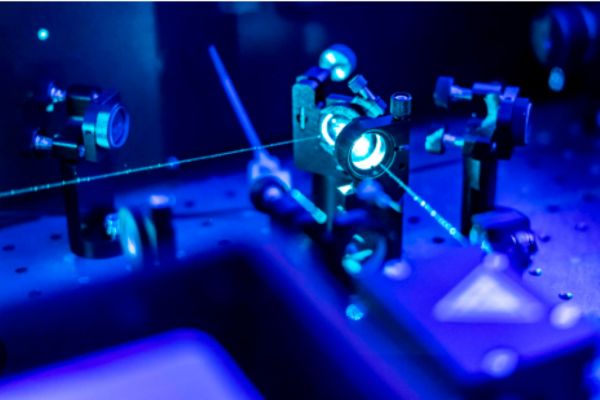Magnetic microscopy over a wide frequency range could help improve the performance of soft magnetic materials in power electronics.
Diamond quantum sensors can be used to analyze the magnetization response of soft magnetic materials used in power electronics; report scientists based on collaborative research. Using a novel imaging technique, they developed quantum protocols to simultaneously image both the amplitude and phase of AC stray fields over a wide frequency range up to 2.3 MHz. Their results demonstrate that quantum sensing is a powerful tool for developing advanced magnetic materials across diverse applications.
Quantum Eyes on Energy Loss: Diamond Quantum Imaging for Next-Gen Power Electronics

Kitagawa et al. (2025) | Communications Materials | 10.1038/s43246-025-00812-4
Improving energy conversion efficiency in power electronics is vital for a sustainable society, with wide-bandgap semiconductors like GaN and SiC power devices offering advantages due to their high-frequency capabilities. However, energy losses in passive components at high frequencies hinder efficiency and miniaturization. This underscores the need for advanced soft magnetic materials with lower energy losses.
In a recent study published in Communications Materials, a research team led by Professor Mutsuko Hatano from the School of Engineering, Institute of Science Tokyo, Japan, developed a novel method for analyzing such losses by simultaneously imaging the amplitude and phase of alternating current (AC) stray fields, which are key to understanding hysteresis losses. Using a diamond quantum sensor with nitrogen-vacancy (NV) centers and developing two protocols—Qubit Frequency Tracking (Qurack) for kHz and quantum heterodyne (Qdyne) imaging for MHz frequencies—they realized wide-range AC magnetic field imaging. This study was carried out in collaboration with Harvard University and Hitachi, Ltd.
The researchers conducted a proof-of-principle wide-frequency-range magnetic field imaging experiment by applying an AC current to a 50-turn coil and sweeping the frequency from 100 Hz to 200 kHz for Qurack and 237 kHz to 2.34 MHz for Qdyne. As expected, the uniform AC Ampere magnetic field’s amplitude and phase were imaged using NV centers with high spatial resolution (2–5 µm), validating both measurement protocols.
The team was able to concurrently map the amplitude and phase of stray magnetic fields from the CoFeB–SiO2 thin films, which were created for high-frequency inductors, by using this novel imaging technique. Their research showed that these films have almost no phase delay up to 2.3 MHz, which suggests that there are very little energy losses along the hard axis. Additionally, they found that the magnetic anisotropy of the material affects energy loss; increased energy dissipation is indicated by a phase delay that rises with frequency when magnetisation is directed down the easy axis.
All things considered, the findings demonstrate how soft magnetic materials functioning at higher frequencies can be analysed using quantum sensing, which is thought to be a significant obstacle in the development of extremely effective electronic systems. It is noteworthy that the ability to resolve domain wall motion—one of the magnetisation methods that is closely linked to energy losses—is a crucial step that will result in significant advancements and improvements in electronics.
Looking forward, the researchers hope to further improve the proposed techniques in various ways. “The Qurack and Qdyne techniques used in this study can be enhanced by engineering improvements,” says Hatano. “Qurack’s performance can be enhanced by adopting high-performance signal generators to extend its amplitude range, whereas optimizing spin coherence time and microwave control speed would broaden Qdyne’s frequency detection range.”
“Simultaneous imaging of the amplitude and phase of AC magnetic fields across a broad frequency range offers numerous potential applications in power electronics, electromagnets, non-volatile memory, and spintronics technologies,” remarks Hatano. “This success contributes to the acceleration of quantum technologies, particularly in sectors related to sustainable development goals and well-being.”
Reference
Authors: Ryota Kitagawa1, Aoi Nakatsuka1, Teruo Kohashi2, Takeyuki Tsuji1, Honami Nitta1, Kosuke Mizuno1, Yota Takamura1, Shigeki Nakagawa1, Takayuki Iwasaki1, Amir Yacoby1,3,4, and Mutsuko Hatano1*
*Corresponding author
Title:Imaging AC magnetization response of soft magnetic thin films using diamond quantum sensors
Journal:Communications Materials
DOI:10.1038/s43246-025-00812-4
Affiliations:1School of Engineering, Institute of Science Tokyo, Japan
2Research & Development Group, Hitachi, Ltd., Japan
3Department of Physics, Harvard University, USA
4John A. Paulson School of Engineering and Applied Science, Harvard University, USA













